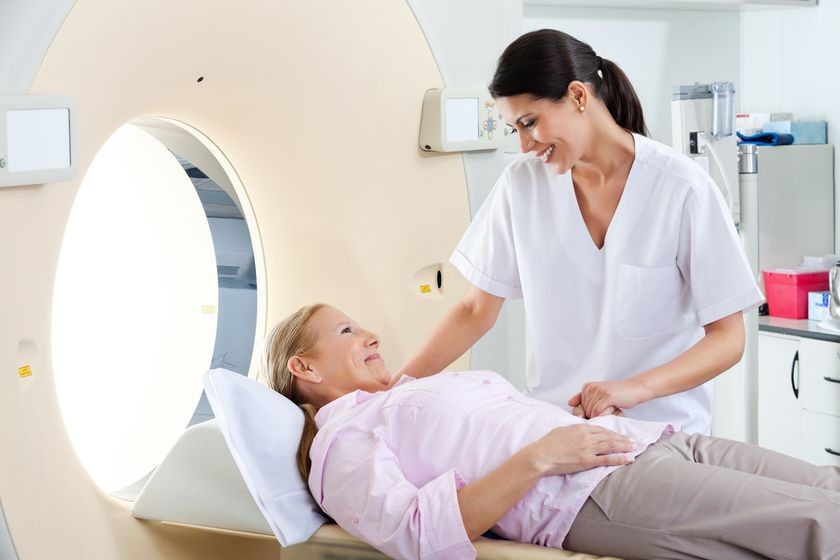
My Periods are Painful. Could it be Adenomyosis?

If you are between the ages of 40 and 50, and are experiencing severe symptoms during or after your period, you may have adenomyosis. This affects your uterus, the hollow muscular organ that carries the baby during pregnancy.
Your uterus is lined with endometrial tissue, also known as the endometrium. This tissue thickens during the menstrual cycle in preparation for the implantation of a fertilized egg. If the woman does not become pregnant, the endometrial tissue breaks down and the woman’s body sheds the broken down tissue during her period.
In adenomyosis, the endometrial tissue that normally lines the uterus actually grows into the walls of the uterus, which are quite muscular. The displaced tissue acts like normal endometrium as it thickens, breaks down and bleed, but this process enlarges the uterus in ways that cause painful, heavy periods.
The rise and fall of estrogen levels during the menstrual cycle stimulate the endometrial cells growing inside the uterus, which makes bleeding and menstrual cramps more severe than usual.
About one in ten women have adenomyosis, according to the National Health Service (NHS) in the UK. Many women with adenomyosis first experience symptoms late in their childbearing years, often after having children. The condition is most common in women aged 40 to 50 years, and the disease typically ease up or disappear completely after a woman goes through menopause.
Women with adenomyosis do not always experience symptoms. In fact, research shows that one in three women with the condition do not experience any symptoms at all. For others, symptoms can interfere with daily life.
Symptoms of adenomyosis may include:
- Heavy menstrual bleeding
- Very painful periods, including severe cramps during menstruation
- Passing blood clots during menstruation
- Painful intercourse
- Bleeding in between periods
- Worsening uterine cramps
- Generalized pain in the pelvic area
- A feeling like there is pressure on the bladder and rectum
- Pain during a bowel movement
- An enlarged and tender uterus
A woman cannot tell if her uterus is enlarged without medical imaging, such as an ultrasound, but she might notice that her lower abdomen seems bigger or feels tender.
Adenomyosis can be difficult to diagnose because many conditions, such as pelvic inflammatory disease, can cause similar symptoms. Furthermore, women with the condition may have different symptoms, and some women do not have any symptoms at all.
Medical science still has not determined the exact cause of adenomyosis, but researchers have several theories. Some think the condition is present in a person before she is born, when the uterus first forms in the fetus. Others think that injury to the uterus during caesarian delivery, inflammation of the uterus during uterine surgery, or injury during other types of surgery may cause the condition as the uterus may heal inwards towards the endometrial lining instead of outward.
Some women may be more likely to develop adenomyosis. Age is a factor, as most women with the condition receive their diagnosis when they are between the ages of 40 and 50. Women who have had multiple pregnancies are more likely to experience adenomyosis. Those who have undergone uterus surgery, such as caesarian delivery, have a higher risk of developing the condition.
While they have not determined the underlying causes of the condition, medical professionals do know how to recognize and treat adenomyosis.
Adenomyosis and its More Well-Known Cousin, Endometriosis
Adenomyosis is similar to endometriosis, which is another condition affecting the endometrium. The big difference between the two conditions is where the endometrial cells grow. In adenomyosis, the endometrial cells grow into the uterus and no further. In endometriosis, the endometrial cells grow outside the uterus and even on the ovaries and fallopian tubes.
Diagnosis and Treatment of Adenomyosis
Treatment of adenomyosis always begins with a thorough evaluation and accurate diagnosis. A doctor may diagnose adenomyosis based on a patient’s signs and symptoms, a pelvic exam that shows the patient has an enlarged, tender uterus, an ultrasound of the uterus, and magnetic resonance imaging (MRI) of the uterus. The ultrasound and MRI create images of the organs in the patient’s pelvis. These images help the doctor detect thickening of the uterus, which indicates adenomyosis.
Treatment depends largely on the severity of symptoms and the patient’s desire to maintain her fertility. Lifestyle and home remedies, such as soaking in a warm tub, applying a heating pad to the abdomen, and over-the-counter medications can alleviate pain.
Medical treatment options include starting a course of anti-inflammatory drugs, such as ibuprofen, two to three days prior to a period to control pain or hormones to control heavy bleeding and pain associated with adenomyosis.
Doctors sometimes recommend hysterectomy to treat severe symptoms of adenomyosis, particularly if the condition causes significant pain and the patient is still several years from menopause. This treatment will interfere with the ability to become pregnant.
If you are a woman who is 40 to 50 years old and has symptoms of adenomyosis, such as prolonged periods, heavy bleeding or severe cramps that interfere with your daily life, consult with your doctor to learn more about the diagnosis and treatment of adenomyosis.




